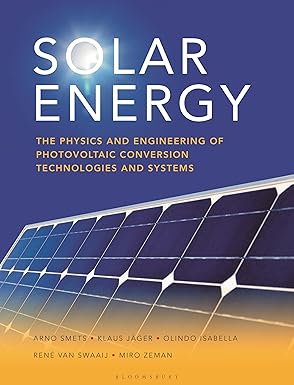Summary: Solar Energy, Photovoltaic Conversion, and MATLAB Simulation (Expanded)
This textbook provides a comprehensive exploration of solar photovoltaic (PV) technology, bridging the gap between fundamental physics, practical engineering, and advanced computational analysis through MATLAB simulations.
Core Focus:
- Physics of Photovoltaic Cells: It delves into the underlying principles of the photovoltaic effect, elucidating efficiency factors (reflectance, thermodynamic efficiency, charge carrier separation) and performance metrics (quantum efficiency, open-circuit voltage ratio, fill factor).
- References:
- Nelson, J. (2003). The physics of solar cells. Imperial College Press.
- Würfel, P., & Würfel, U. (2015). Physics of solar cells: from basic principles to advanced concepts. John Wiley & Sons.
- References:
- Engineering and System Design: The text covers the engineering aspects of integrating solar cells into panels and arrays, addressing module efficiency, wafer and glass thickness considerations, and the critical role of DC to AC conversion using inverters.
- Use Cases:
- Designing residential rooftop solar systems with optimal panel orientation and inverter sizing.
- Developing large-scale solar farms, considering grid integration and power output stability.
- Designing off grid systems for remote telecommunication towers.
- References:
- Masters, G. M. (2013). Renewable and efficient electric power systems. John Wiley & Sons.
- Quaschning, V. (2019). Renewable energy and climate change. John Wiley & Sons.
- Use Cases:
- Technological Advancements: It highlights the rapid evolution of PV technology, showcasing current efficiency records (47.6% as of 2024), advancements in material reduction, manufacturing processes, and wafer thinning.
- References:
- Green, M. A., Emery, K., Hishikawa, Y., Warta, W., & Dunlop, E. D. (2019). Solar cell efficiency tables (version 54). Progress in Photovoltaics: Research and Applications, 27(1), 3-12.
- National Renewable Energy Laboratory (NREL) publications on PV research.
- References:
- Environmental Impact and Energy Payback: The book addresses the environmental benefits of solar energy, emphasizing its zero-emission operation and analyzing energy payback time (EPBT) considerations, alongside improvements in manufacturing efficiency.
- Use Cases:
- Conducting life cycle assessments (LCAs) of PV systems to evaluate their environmental footprint.
- Analyzing the impact of solar energy deployment on reducing greenhouse gas emissions.
- References:
- IRENA (International Renewable Energy Agency) reports on renewable energy benefits.
- Fthenakis, V. M., & Zweibel, K. (2003). CdTe photovoltaics: life cycle environmental inventory and risk assessment. Progress in Photovoltaics: Research and Applications, 11(5), 275-290.
- Use Cases:
- Future Prospects: It explores the future of solar PV, focusing on expected advancements in efficiency, cost reduction, durability, and seamless integration with energy storage systems.
- Use Cases:
- Modeling future energy scenarios with high penetrations of solar PV and energy storage.
- Developing smart grid solutions that incorporate distributed solar generation and demand-side management.
- References:
- IEA (International Energy Agency) reports on renewable energy technology roadmaps.
- Publications relating to smart grid technologies.
- Use Cases:
- MATLAB Simulation: A significant portion of the text is dedicated to MATLAB simulations, enabling users to model single solar cells using the single-diode equation, simulate PV arrays and scaling, generate I-V and P-V curves, and model environmental factors (irradiance, temperature, shading). It also delves into advanced techniques like digital datasheet generation, real-time simulation, and MPPT algorithm testing, providing practical applications for system design and optimization.
- Use Cases:
- Optimizing maximum power point tracking (MPPT) algorithms for PV inverters.
- Simulating the performance of PV systems under various shading conditions.
- Creating digital twins of solar installations for performance monitoring and predictive maintenance.
- Simulating the effect that various environmental factors have on solar installations.
- References:
- Lorenzo, E. (1994). Solar electricity: engineering of photovoltaic systems. Progensa.
- Villalva, M. G., Gazoli, J. R., & Filho, E. R. (2009). Comprehensive approach to modeling and simulation of photovoltaic arrays. IEEE transactions on power electronics, 24(5),1 1198-1208.
- Use Cases:
Key Strengths:
- Interdisciplinary Approach, Practical Application, Up-to-Date Information, Comprehensive Coverage.
Target Audience:
- Students, researchers, and professionals in renewable energy, electrical engineering, and materials science.



